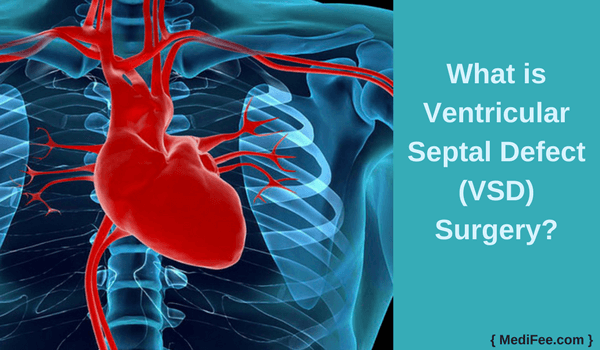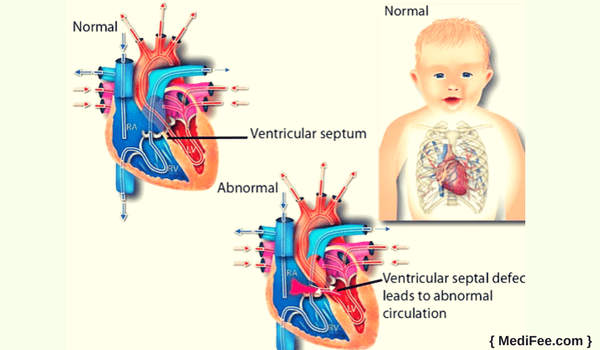Ventricular Septal Defect (VSD) Surgery
Listed below is the step by step procedure of vsd surgery:
- What is Ventricular Septal Defect (VSD) Surgery?
- Why is Ventricular Septal Defect (VSD) Surgery Required?
- Pre-operative Preparation
- Day Before Surgery
- Procedure Day
- Methods/Techniques of Ventricular Septal Defect (VSD) Surgery
- Post Procedure
- Risks and Complications
What is Ventricular Septal Defect (VSD) Surgery?
VSD surgery is implemented to treat ventricular septal defect , which is a congenital heart defect i.e., it is present since birth. In this defect, a hole is present on the septum that separates lower chambers of the heart (right ventricle and left ventricle). VSD surgery treats this defect by closing the hole.
Open surgery is generally performed on infants or during childhood to prevent serious complications. Small holes get closed on their hole and surgery may not be necessary. But, larger holes cannot heal or close on their own and surgery becomes mandatory.

Why is Ventricular Septal Defect (VSD) Surgery Required?
Smaller holes in septum of heart heal on their own over a period of time. However, larger holes require surgery as a treatment procedure. Medications do not work to heal large holes. Ventricular septal defect (VSD) surgery is the only option.
To identify ventricular septal defect (VSD), murmurs can be heard after birth in many infants. However, they are not noticeable for 6-8 weeks after birth. Baby with VSD has poor growth and heart failure can occur within baby's first two months.

To avoid future complications and improve baby's or child's health and save the defect from becoming fatal, VSD surgery is required.
Pre-operative Preparation
Before VSD surgery, your cardiologist will recommend some heart checkup tests for your child. They include tests like:
- Chest X-rays to check anatomical structure of heart
- Echocardiogram to check functioning of heart and to monitor blood flow
- Electrocardiogram to assess rhythm of heart
- Blood tests to check overall health status, hemoglobin level and presence of infection
- Other diagnostic tests may also be conducted to check for abnormalities present in other part of the body
Day Before Surgery
Day before the surgery, child is admitted to the hospital and all the legal documents are signed. It is recommended that the child does not drink or eat after midnight prior to the day of surgery. Cardiologist may discontinue all the medications before the surgery. However, it is not a mandatory thing. Vitals, such as blood pressure, overall body temperature, pulse rate etc. will be monitored.
Parents have to make arrangement for blood transfusions to avoid last minute hassle and trouble. If any emergency situation calls for it, you are ready and do not have to panic.
Procedure Day
On the procedure day, legal formalities have to be completed for the operation to commence. Parents have to ensure that they complete all the legal formalities like signing of document on time so that further complications like delaying the time of surgery will not arise.
Vitals of the patient are again checked and signs of abnormalities are monitored. The child is taken to operation theater where the surgery may take long time; around 5-6 hours approximately. Time may extend or decrease depending upon complexity of the surgery.
Methods/Techniques of Ventricular Septal Defect (VSD) Surgery
- Anesthesiologist will intravenously inject general anesthesia so that the child remains unconscious throughout the surgery.
- Since it is an open heart surgery, a long incision will be made on the middle of the chest and breastbone will be separated to access heart.
- Once the heart is accessed, child will be attached to heart-lung machine that temporarily performs function of heart and lungs. In this way, the bodily function do not get interrupted.
- By accessing valve, surgeon is able to reach hole located in the lower heart chambers. The hole in the ventricles will be closed using tightly woven special patch material. On closure of hole, heart-lung machine will be removed. Breastbone will be placed back together with the help of wires.
- Muscle and skin will then be closed and there would be stitches made.
Post Procedure
VSD surgery, in most of the cases, permanently cures ventricular septal defect. Since, it's an inpatient procedure, your child will be in the hospital for few days and spend several hours in recovery room. Below mentioned are some of the precautions that have to be practiced post VSD surgery:
- Medications that have been prescribed by cardiologist have to be taken on time. Adhering to the schedule of medicines will ease out pain, prevent development of infection and keep complications at bay.
- All follow-up appointments need to be strictly adhered to for monitoring child's progress. Also, the child needs to get stitches removed during follow-up appointments. Abnormalities like swelling, bleeding, fever etc. can be detected during these appointments.
- For a certain period post VSD surgery, if your child has to be operated for dental disorders or certain medical procedures, let that doctor know about your child's condition of VSD. Antibiotics may be administered to prevent infection of heart valves.
- Children can bounce back to their normal routine life once they are discharged from the hospital. However, they may get tired soon after doing any physical activity. It is better to avoid any strenuous activities that exert undue pressure on cardiac muscles.
- Parents have to ensure that their child follows diet and exercise regime suggested by their cardiologist. Healthy and nutritious diet plays a key role in accelerating recovery process. Since the surgery inevitably includes blood loss, iron-rich foods, such as dates, raisins, green leafy vegetables etc. should be given to children. In case of infants, it is better that the mother consults with paediatrician and cardiac surgeon about breastfeeding schedule.
Risks And Complications
Ventricular septal defect (VSD) surgery generally goes well and most of the children do not face any major complications post surgery. However, some risks and complications may develop in rare cases. Let us have a look at those complications:
- Excess bleeding: When open heart surgery is being performed, excess bleeding may occur. This can prove dangerous; especially when VSD surgery is being performed on infants.
- Infection: Infection can occur when VSD surgery is being performed. Heart infection may become fatal and hence, to avoid development of infection, cardiologists prescribe antibiotics which have to be taken on time.
- Blood clot: If blood clot develops after VSD surgery, it can lead to stroke and that can become fatal. Every organ needs supply of oxygen rich blood to perform efficiently. Heart also needs constant supply of pure or oxygenated blood to perform its function of blood circulation. The function of supplying pure blood to heart is done by coronary arteries.
- Injury to valves: VSD surgery can lead to injuries to valves such as tricuspid valve. Injuries may even occur to the largest artery in the body - aorta.
- Abnormal heart rhythm: During open heart surgery, heart undergoes period of cold ischemia which in simple terms can be explained as no blood flow. This causes myocardial function (function of muscles of heart) to decrease even though efforts are being made to protect cardiac muscles through process of cooling and cardioplegia (temporary or intentional end of cardiac activity). Heart needs time to adapt or acclimatize to new anatomical change and that results in abnormal heart rhythms during initial phase. Some patients may require pacemaker to retain normal heart rhythm.
- Anesthetic complications: Anesthetic complications are common ones and normally fade away after few days post surgery. Patient may feel uneasy or uncomfortable for some period of time.

